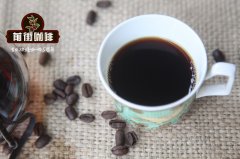What is the flavor of Kaddura with the whole berry treatment of alpine extremely hard beans in the new Nordega region of Nicaragua?

Professional coffee knowledge exchange more coffee bean information please follow the coffee workshop (Wechat official account cafe_style)
What is the flavor of Kaddura with the whole berry treatment of alpine extremely hard beans in the new Nordega region of Nicaragua? How to get a refreshing and balanced taste with your hands?
Coffee cultivation in Nicaragua began in the mid-18th century, with most of the coffee grown in the central and
The northern plateau. Coffee is produced in 10 of the 16 provinces. Due to the high mountains in the north-central region
It is more suitable for coffee cultivation, so 93% of the country's output comes from the four northern provinces:
Jinotega, Matagalpa, Nueva Segovia and Madriz. New Nordega (Jinotega)
And the areas of Matagalpa and Nueva Segovia are
Coffee is one of Nicaragua's main exports, due to volcanic ash and tree shade.
Shaded planting produces high-quality Nicaraguan coffee with a balanced and soft flavor.
Slightly sour, suitable for individual and mixed coffee. The coffee produced in Nicaragua has a taste.
Refreshing and balanced is the most important feature, and the amazing thing is that the coffee produced by it is roasted shallowly.
Clean, bright, sour, delicate and soft style, sweet and thick when deep baked
Mellow and full-bodied taste. Coffee is Nicaragua's main export crop, all of Nicaragua
Coffee is grown in fertile volcanic soil, with an average elevation of more than 1200 meters.
S.H.G. Gao Shan Dou. Gaoshan beans are famous for their slight acid, medium to high concentration and good smell.
The main variety is Cuturra, and the United States is the largest importer.
Nicaragua is located in central Central America, bordered by the Pacific Ocean to the west and the Caribbean Sea to the east. The north and central part is the highland.
In the east is the coastal plain, which is part of the Central American volcanic belt, which provides excellent for the cultivation of coffee.
The growing environment. There is a unique environment for coffee production in Nicaragua.
The fertile pozzolanic soil, coupled with shaded planting methods, has established good production quality.
Coffee has a rich mellow and fragrant flavor, moderate acidity and sweet taste.
The sense of balance is excellent, and it is highly rated by international coffee experts. High quality Nicaraguan coffee
Shade planting is its characteristic, while coffee beans are washed and dried in the sun. Its coffee bean phase
Compared with other countries, they are larger. Especially the Mara Guojippe produced in Madagelba district.
(Maragogipe) A very large species of coffee beans called elephant beans, with clear
Taste and excellent aroma, this round and soft texture, has a very high evaluation in the market.
This batch of coffee beans adopts natural farming method, coupled with high-tech planting management technology, not only with microorganisms.
Fertilization with probiotics can strengthen the resistance of coffee trees to diseases and insect pests and produce high-quality gourmet coffee.
And use organic nutrients to protect the soil. Hand-harvested fully ripe red fruit coffee beans
Miel processing and self-developed natural pectin and whole berry treatment (Whole Gel Process)
Increase the sweetness, mellowness, clean aroma, mild acidity and balance of coffee
Excellent taste, with multiple fruit aromas and sweet drupe chocolate. Since 2008
Won the national and international coffee competition participants used as coffee beans for the competition every year.
It is unique in the fine coffee in Central American countries, and the coffee industry in Europe, America and Japan all think highly of it.
Flavor features: elegant flower aroma with soft acidity, exquisite drupe sweetness and excellent balance
Show an elegant and fragrant temperament.
Planted with volcanic ash and shaded trees, it produces high-quality Nicaraguan coffee with a mediocre, soft and slightly sour flavor, which is suitable for comprehensive coffee. The volume of Nepalese coffee is the largest of all coffee beans, among which the giant beans produced in Madagelba are the most distinctive. This kind of giant bean particles are larger than ordinary coffee beans, commonly known as elephant beans, with a distinctive special flavor, but also with the round texture of Maragogipe coffee, its sister product Matagalpa contains wild acidity and indescribable aroma.
The coffee trees in this area are several ancient bourbon species, which are usually planted on the hillside of 1200 murmur1500 Michael above sea level, and have been recognized as excellent organic coffee at high altitude by the Organic crop improvement Association (OCIA). Nepalese coffee is particularly suitable for deep roasting and is recommended for brewing espresso.
Flavor features: there are rich fruit aromas and full acidity throughout the process, fully exposed
The fruit nature of ripe coffee berries. The fragrance of pomelo flower and the creamy drupe in the end.
It is sweet and intertwined, with both the elegance of Central America and the rich taste of unrestrained emotion in Africa.
Country of origin: Nicaragua (Nicaragua)
Producing area: new Nordega (Jinotega) area
Variety: Kaddura variety (Caturra)
Grade: Alpine extremely hard beans
Planting methods: the whole process from seedling raising, shading planting, ecological organic microorganism fertilization and planting
Shading planting of shading trees in the whole area & ecological planting
Altitude: over 1200 m
Average annual temperature: 20-22C
Treatment: whole berry treatment (Whole Fruit Process)
Harvest time: December to March of the following year
Certification / testing: passed SGS,TUV Rheinland 368 pesticides and ochratoxin test
Drying method: natural solarization / off-ground drying of African bed / drying in sunlight greenhouse
Qianjie recommended cooking method: hand flushing
V60 filter cup, 15g powder, water temperature 89 degrees, small Fuji grinding degree 4, water powder ratio close to 1:15.
30 grams of water steaming, steaming time for 30 seconds, subsection: injection to 130 grams of water cut off, such as the water level dropped by 1 stroke 3, again water injection to 225 grams.
Important Notice :
前街咖啡 FrontStreet Coffee has moved to new addredd:
FrontStreet Coffee Address: 315,Donghua East Road,GuangZhou
Tel:020 38364473
- Prev

The flavor of honey-treated beans in Alajuela, Althacia, Costa Rica. Brother
Professional coffee knowledge exchange more coffee bean information please follow the coffee workshop (Wechat official account cafe_style) [adobe farmers] in Alajuela, Althacia, Costa Rica.
- Next

What are the recommendations for sour coffee beans? introduction to the taste characteristics of shallow roasted coffee beans
Professional coffee knowledge exchange more coffee bean information Please follow the coffee workshop (Wechat official account cafe_style). On weekdays, you can get in touch with all kinds of guests at the bar. A considerable number of these guests are unaccustomed to sour coffee beans, while usually sour coffee is roasted.
Related
- Detailed explanation of Jadeite planting Land in Panamanian Jadeite Manor introduction to the grading system of Jadeite competitive bidding, Red bid, Green bid and Rose Summer
- Story of Coffee planting in Brenka region of Costa Rica Stonehenge Manor anaerobic heavy honey treatment of flavor mouth
- What's on the barrel of Blue Mountain Coffee beans?
- Can American coffee also pull flowers? How to use hot American style to pull out a good-looking pattern?
- Can you make a cold extract with coffee beans? What is the right proportion for cold-extracted coffee formula?
- Indonesian PWN Gold Mandrine Coffee Origin Features Flavor How to Chong? Mandolin coffee is American.
- A brief introduction to the flavor characteristics of Brazilian yellow bourbon coffee beans
- What is the effect of different water quality on the flavor of cold-extracted coffee? What kind of water is best for brewing coffee?
- Why do you think of Rose Summer whenever you mention Panamanian coffee?
- Introduction to the characteristics of authentic blue mountain coffee bean producing areas? What is the CIB Coffee Authority in Jamaica?

